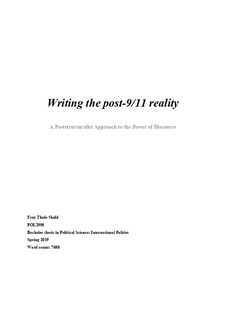Writing the post-9/11 reality
Bachelor thesis
Permanent lenke
http://hdl.handle.net/11250/2613643Utgivelsesdato
2019Metadata
Vis full innførselSamlinger
Sammendrag
Narratives are essential in the construction and breeding of social reality. The 9/11 attacks generated highly threatening narratives and contradictory identities that ultimately resulted in an enduring ‘war on terror’. Wars are not only physical; they are anticipated and accompanied by narratives and discourses, including language that identify enemies which ought to be fought. In order to understand enemies in a war, one needs to understand the rhetorical techniques used to create the identities of ‘us’ and ‘them’ within that context. Following 9/11, the Bush Administration managed to create a sense of war, (re)construct conflicting identities, and establish a notion of supreme emergency. My thesis aims to conceptualize the discursive construction of reality in the aftermath of 9/11, and it shall illustrate how the usage of language is always maneuvered to convey the objectives of the speaker in order to influence the audience. It reveals the way Bush strategically developed his threat narrative, that initially consisted of dissident terrorists, but evolved into an existential threat that included an ‘axis of evil’ possessing weapons of mass destruction. Bush’s strategic and subjective concerns are quantified using a Critical Discourse Analysis (CDA), in which quotes are collected from official speeches given by the President from September 11, 2001, to January 29, 2002. Engaging with the poststructuralist line of thought, Fairclough’s CDA thus provides an innovative framework of thought to assess the way in which Bush securitized constructed the war on terror as the only applicable response to the 9/11 attacks.
